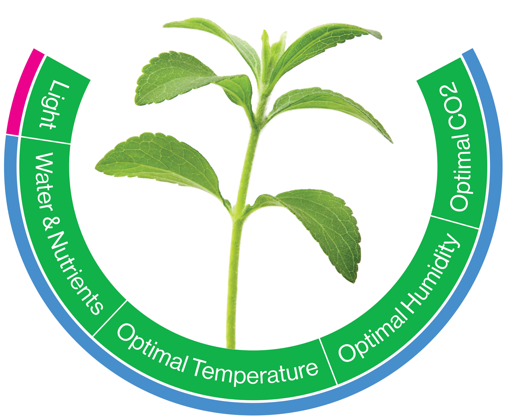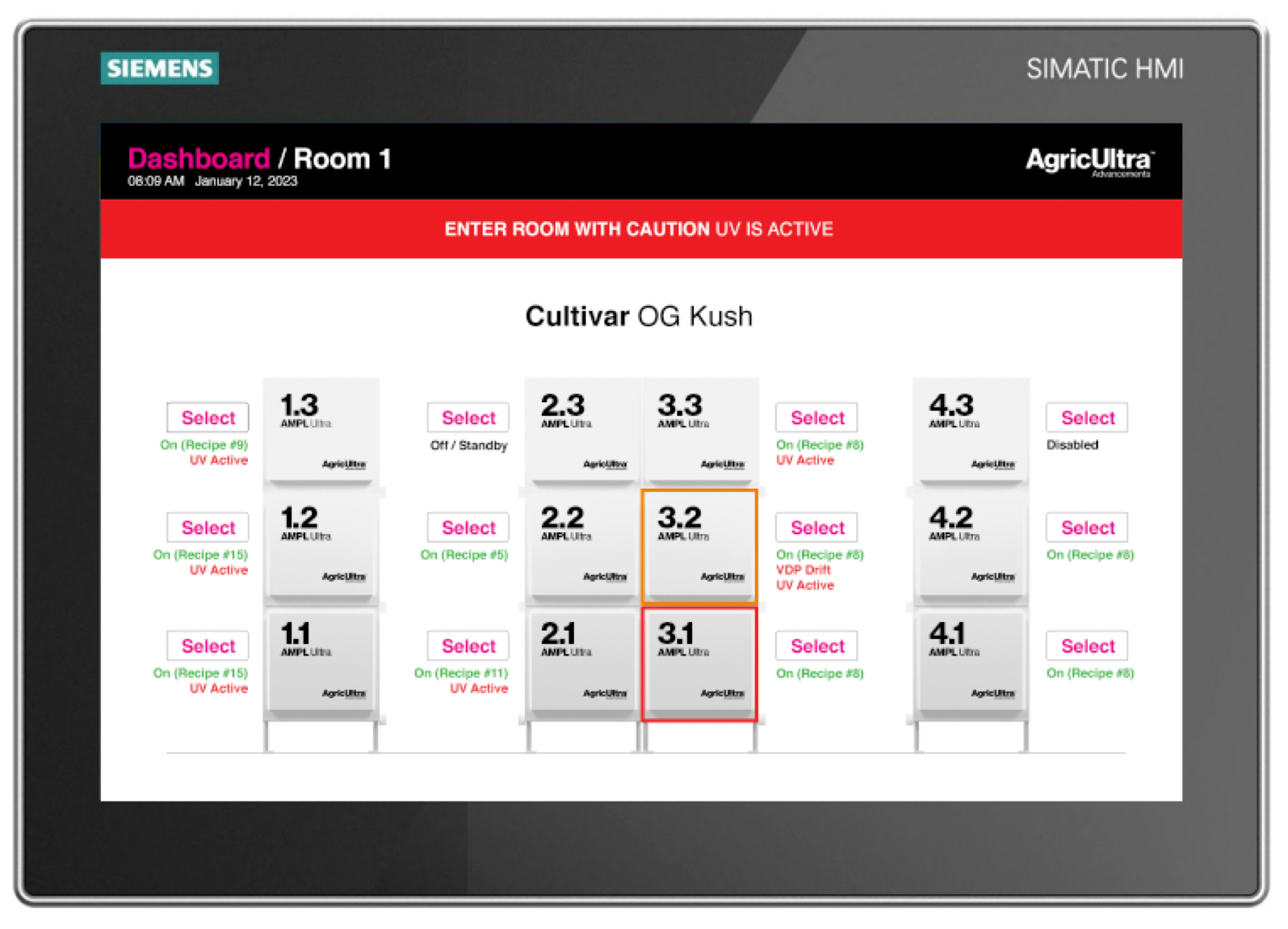The AMPL Platform™
Push/Pull Ascending Airflow System
The AMPL Platform achieves optimal environmental conditions around each plant in a facility regardless of its climatic requirements and location in a grow system. By effectively managing the byproducts of photosynthesis, heat generated by grow lights, and reducing evapotranspiration, AMPL greatly expands the variety and scale of crops that can be grown indoors.
Our Plant First™ approach to problem-solving and expertise in computational fluid dynamic modeling (CFD) made it clear that existing methods of vertical farming drastically underestimate the importance of airflow – Optimized air management is fundamental to the success of vertical farming at scale. AgricUltra Advancement™ has dedicated over half a decade to solving airflow management issues in commercial grow facilities which resulted in the development of the AMPL Platform’s Push/Pull Ascending Airflow System.
Airflow is Vital to Plant Health
Everything that a plant needs to thrive is governed by air control.
Water & Nutrients: A difference in pressure between water vapor within leaves and their ambient atmosphere enables plants to absorb water and nutrients through their roots. Without proper climate conditions, nutrients and water cannot be delivered to cells.
Optimal Gas Exchange: To maximize a plant’s ability to draw C0₂ and expel oxygen, plants require a dynamic balance of temperature, humidity, and air velocity.
Light: Without sufficient CO₂, photons are wasted which reduces the efficiency of grow lights.
A Mold & Pathogen Free Environment: Stagnant air provides ideal conditions for mold and pathogens that can cause disease.
How Plants Breath – Transpiration, VDP, and the Boundary Layer
To gain a better understanding of how plants breathe (transpire) and why controlling air temperature, air velocity and air moisture are essential for optimizing crop performance, click here.
AMPL™ Masters Airflow with Push/Pull Ascending Airflow
Treated Air is Pushed Upward
Conditioned, C0₂ enriched air is delivered to the base of each plant and pushed through the canopy equally down the length of each production layer.
Ascending airflow also reduces the often-overlooked issue of excess humidity caused by air movement over grow mediums
(Fig. 1). Reduced evapotranspiration results in less energy spent on dehumidification and eliminate grow medium parching.
Fig. 1 Horizontal and Descending vs. Ascending Airflow
Spent Air is Pulled Upward
Inter-canopy ducts remove the by-products of photosynthesis and problematic heat generated by grow lights directly at their source, removing spent air before it can degrade the surrounding environment. By abandoning the concept of spent and conditioned air mixing we have eliminated microclimates and overcome the environmental limitations of multi-layer canopies grown indoors.
CDF Modelling has proven that multi-tier systems that do not remove excess heat and humidity at the canopy level experience accumulated environmental effects due to the unavoidable fact that hot air rises. Understanding and exploiting this fact leads back to our second design principle – Don’t fight physics. It’s inefficient.
Naturally occurring phenomena can be leveraged. Push/Pull Ascending Airflow takes advantage of the natural buoyancy of heat generated by grow lights, ascending airflow reduces CFM requirements, and does not decimate leaf boundary layers with high-velocity airflow required by horizontal and descending airflow methods at scale.
Room-Level Air Mixing is a Deprecated Concept
Horizontal and descending airflow systems rely on room-level mixing of spent and conditioned air that is continually treated by bulk air HVAC systems. Since they do not direct canopy level exhaust, they compensate for heat and moisture accumulations with lateral fans to increase spent and conditioned bulk air mixing meant to homogenize the entire volume of air in a grow room. This inevitably leads to uncontrollable microclimates. Sporadic airflow results in inconsistent VDP control and ultimately poor crop performance.
Illustrated impact of horizontal and descending airflow systems.
Temperature CFD model demonstrating the inherent issues of descending airflow systems.
Based on extensive CFD modeling and real-world facility analysis we are confident that bulk air mixing and horizontal and descending airflow methods are not appropriate for high-density, multi-tier vertical farms. Learn more in our white paper, The inherent Flaws of Bulk Air Mixing Airflow Systems.
AMPL Precision Airflow Nozzles
Automotive-grade precision airflow nozzles can be adjusted to compensate for the unavoidable pressure drop that occurs as pressure changes down the length of a duct.
Custom nozzles and combinations of nozzles can be developed to:
1. Satisfy specific plant requirements
2. Achieve specific project goals
3. Achieve specific airflow patterns
CFD Model of Airflow Nozzle Combination
CFD model of balanced air velocity in an eight-layer AMPL Pro system (Side View).
Balanced Airflow has an Extraordinary Impact on Sensor Data Quality
By eliminating microclimates, sensors data quality can be far better relied upon to make meaningful decisions during production to adjust for crop variability and a grower’s ability to develop proprietary expressions of common genetics.
AgricUltra Advancements customizes human-machine interfaces (HMIs) for clients to match control and data collection requirements.
Optional Data Collection Points
• Plant Health
• Visual Imaging
• VDP
• Transpiration
• MicroCoil Efficiency
• Reheat Coil Temp
• Cooling Coil
• Relative Humidity
• Comparative Temperature
• Realtime Biomass
• Lighting Efficiency
• RHC / CC Temp Delta
• Fan Speed
• Irrigation Flow
• PH
• Neurite Uptake
• QA
• Product Traceability
Please Note: Options vary depending on AMPL Model
The AMPL Platform is Available in Four Models
AMPL Ultra™
An Independent Hydronic MicroCoil Based System
AMPL Ultra offers the ultimate in environmental control, energy management and flexible production. Independent MicroCoils turn each layer into its own growing environment, enabling growers to match output to market needs. AMPL Ultra is even capable of growing different crops on different layers**. Hydronic technology also eliminates the need for bulk air ducts, simplifying facility design. AMPL Ultra is an elegant solution for pharmaceutical horticulture and large-scale plant factories with unique output requirements.
AMPL Pro™
A Bulk Air Based Environmental System
AMPL Pro utilizes controlled bulk air diffusion and directed inter-canopy bulk air conditioning. This is the most cost-effective means of implementing Push/Pull Ascending Airflow in high-volume plant factories pending production goals or small to medium size grow rooms intended for vascular plants with high environmental requirements.
AMPL Sprout™
Turn-Key Research & Product Development System
AMPL Sprout™ is a small-scale hydronic MicroCoil based grow system. It is a more cost-effective option for educational institutions than traditional research grow chambers. When used as a product development tool in commercial facilities, R&D scales seamlessly to AMPL Pro and AMPL Ultra systems.















